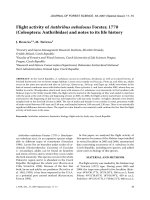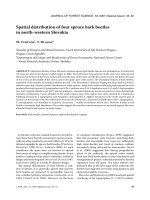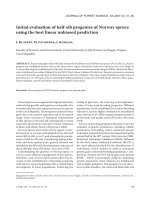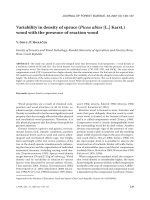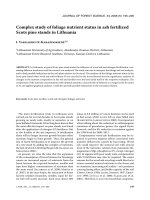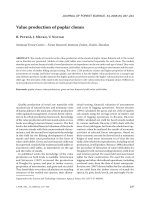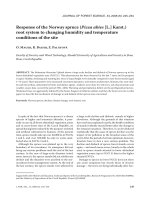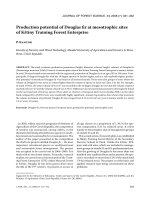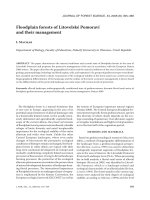Báo cáo lâm nghiệp: "Current possibilities of using Norway spruce (Picea abies [L.] Karst.) in forest regeneration in the air-polluted region of the northeastern Krušné hory Mts" doc
Bạn đang xem bản rút gọn của tài liệu. Xem và tải ngay bản đầy đủ của tài liệu tại đây (367.23 KB, 11 trang )
376 J. FOR. SCI., 55, 2009 (8): 376–386
JOURNAL OF FOREST SCIENCE, 55, 2009 (8): 376–386
e pollution and ecological status of the Krušné
hory Mts. was gradually worsening in the period
from the turn of the 19
th
and 20
th
century to the
early 1990s (M 1988; V 1988; K
et al. 1992). Damage culminated at the turn of the
1970s and 1980s when a massive dieback occurred
in Norway spruce. As to forest management meas-
ures, characteristic was a transition from small-scale
management to large-scale measures, which was
brought about by new technologies and procedures
in soil preparation and reforestation. K
(1982) pointed to profound and specific changes of
bioclimatic processes following the elimination of
mountain spruce stands such as changed radiation
status (change of the albedo, pronounced cooling at
night, development of frost lakes), increased soil wa-
ter supply and changed air flowing due to the change
in terrain roughness.
Great losses in reforestation led to the elimina-
tion of main commercial tree species from the re-
generation objectives. Artificial stands of Norway
spruce and silver fir totally failed (B 1986).
Supported by the Ministry of Education, Youth and Sports of the Czech Republic, Research Plan No. MSM 6215648902, and
the Ministry of Agriculture of the Czech Republic, Project No. QG 60060.
Current possibilities of using Norway spruce
(Picea abies [L.] Karst.) in forest regeneration
in the air-polluted region of the northeastern
Krušné hory Mts.
P. K, O. M
Faculty of Forestry and Wood Technology, Mendel University of Agriculture and Forestry
in Brno, Brno, Czech Republic
ABSTRACT: e paper analyses possibilities of repeated use of Norway spruce (Picea abies [L.] Karst.) in the regen-
eration of existing Norway spruce stands, in the regeneration of large-area clearcuts, and in the reconstruction of the
stands of substitute tree species (European white birch [Betula verrucosa Ehrh.]) after a change in the emission situation
in the northeastern Krušné hory Mts., comparing the prosperity of these plantations with plantations in the unpolluted
Bohemian-Moravian Upland. e survey included 26 research plots aged 1–12 years, situated predominantly on acidic
sites in Forest Altitudinal Vegetation Zones (FAVZ) 6 and 7 in the northeastern Krušné hory Mts. (air pollution damage
zones A and B) and 6 control plots aged 4–11 years on acidic sites of FAVZ 6 in the Bohemian-Moravian Upland (air
pollution damage zone C). Total number of parameters and traits assessed in each tree was up to 14. Research results
indicate that the current pollution and climatic situation in the Krušné hory Mts. allow a switch to the classical spruce
management system of higher elevations. e best method of regeneration is seen in small-size regeneration elements
– clearcuts of up to 1 ha. e spruce can also be used on large-area clearcuts, but it suffers from a long transplanting
shock and frost injuries there. All plantations must be protected against game damage.
Keywords: air pollution; forest regeneration; Norway spruce; clearcuts; reconstruction of stands of substitute woody
species
J. FOR. SCI., 55, 2009 (8): 376–386 377
In contrast, European beech was considered a spe-
cies considerably tolerant to air pollution, its use
was however made impossible due to the climatic
extremity of extensive clearcuts (Š 1982;
T 1985). us, new species started to be used
in the changed air-pollution and ecological condi-
tions in addition to the European white birch and
European mountain ash such as spruce and pine
exotic species, European larch and mountain pine.
eir stands are referred to as the stands of substi-
tute species (SSS). In the 1970s and 1980s, more
than 30,000 ha of SSS were established in the region
concerned.
Since the coming into existence of the stands of
substitute species, an emphasis has been put on
their soil-protective function and water-manage-
ment role. M and T (1998) stated that the
stands of substitute species had fulfilled expected
functions and that the regeneration of large-scale
clearcuts would have failed without them. However,
some SSS show decreased vitality in the course
of cultivation and dynamically worsening general
health condition. A considerable share in the im-
paired vitality is attributable to biotic agents and
namely to the technologies of carried out works
– e.g. whole-area soil preparation with the removal
of humus and overlaying soil horizons (J 1982;
M et al. 2005).
Currently existing adult or juvenile stands are used
only to a limited extent for regeneration by under-
planting or undersowing both in this country and
abroad. is is due to experience gained from the
regeneration under shelterwood whose virtue is – as
compared with the regeneration of even-aged stands
– a more favourable microclimate, vegetation status
and cycling of nutrients (G 1976). In air-pol-
luted regions, it is useful to underplant in advance
so that young plantations of more tolerant species
are already established in case that the stands are
severely affected by air pollution (P 1987; L-
, V 1993; S 1997). It was found
out that a disintegrating stand has a favourable ef-
fect on reducing wind velocity, on counterbalancing
temperature oscillations, it slows down snow melt-
ing, reduces ground storey coverage etc. (L,
V 1991a).
The height growth of artificial crops from the
1990s underplanted in dying stands and on clearcuts
in the Krušné hory Mts. essentially differed at juve-
nile stage. e height growth differentiation began
to show only after 4 or 5 years of cultivation when
the plants passed over the shock induced by trans-
planting. Mortality was higher in the underplanted
crops than in the young plantations on clear-felled
areas (K 2002). In the majority of cases, the
plantations of individual species reached lesser mean
heights and biomass weights under the stand than on
the clearcut, and the recorded cumulative damage to
trees was greater under the stand than on the clear-
cut. e highest values of contaminants were found
in the snow sampled in tree crowns (snow and frost),
under crowns, and the lowest values were detected
on the clearcuts (L, V 1991a,b).
e goal of this paper was to assess the current
state, prosperity and damage to the planted and
underplanted Norway spruce in the air-polluted
region of the northeastern Krušné hory Mts. in vari-
ous stand situations, and to compare the condition
of young Norway spruce plantations and younger
stands growing on similar sites and in similar stand
situations in the air-polluted region of the Krušné
hory Mts. and in the unpolluted region of the Bohe-
mian-Moravian Upland.
MATERIAL AND METHODS
– Research plots were established on properties
under the management of Forests of the Czech
Republic, Ltd. (Lesy České republiky, a. s.). A total
of twenty-nine young plantations and stands aged
1–12 years were analyzed in the Krušné hory Mts.
in various stand situations. e number of control
young plantations and stands of corresponding
age assessed in the Bohemian-Moravian Upland
was six (characteristics of research plots see Ta-
ble 1).
– All measurements were done in 2006.
– e losses recorded before 2006 were computed
using the number of plants set out per hectare and
area of the study site.
– e research plots were marked with the following
codes:
● Clearcuts: H-3-0.11 (Clear-felled areas – Age
[3 years] – Area [0.11 ha]);
● Underplanting of existing Norway spruce stands:
P-6-0.5 (Underplanting – Age [6 years] – Stand
density [0.5]);
● Underplanted birch (SSS reconstruction): RB-
7-0.3 (Reconstruction of birch – Age [7 years]
– Stand density [0.3]);
● Control Bohemian-Moravian Upland:
–KH-6-1.4 (Clear-felled area control – Age
[6 years] – Clearcut size [1.4 ha]);
–KP-8-0.5 (Underplanting control – Age
[8 years] – Stand density [0.5]);
– Forest type groups:
● Number = Forest Vegetation Zones (8 = spruce,
7 = spruce with beech, 6 = beech with spruce);
378 J. FOR. SCI., 55, 2009 (8): 376–386
Table 1. Characteristics of research plots, total height, increment, vitality, stem and crown shape, damage to plants
Stand situation
Plot code
Forest type group
Air pollution damage zone
Clearing (ha)
Under-
planting
Fencing
Total mean height (cm)
Mean increment 2006 (cm)
Losses since 2006 (%)
Vitality
Crown shape
Stem shape (in % of trees) Damage to plants (in % of trees)
Stocking
Stand height (m)
Straight 06
Forked stem 06
Multiple 06
Straight older
Forked stem
Multiple older
Undamaged
Terminal browsing
Dry top
Lateral browsing
Frost
Hylobius
Adelges
Chlorosis
Defoliation
Transplanting shock
Regeneration of small-scale
clearings
H-1-1.00 7K A 1.00 – – no 31.6 ± 6.6 7.2 ± 3.6 14 2.0 1.0 100 0 0 100 0 0 26 22 3 0 3 58 0 0 0 11
H-2-1.00 6K B 1.00 – – no 57.9 ± 12.4 3.9 ± 3.9 12 1.3 1.0 76 5 19 100 0 0 55 12 5 2 0 0 0 24 0 14
H-3-0.11 7K A 0.11 – – no 39.6 ± 9.1 9.0 ± 5.0 6 1.1 1.2 78 17 5 90 7 3 50 30 3 14 19 0 2 0 0 0
H-3-0.06 7K A 0.06 – – no 36.2 ± 10.2 9.5 ± 4.9 8 1.2 1.1 92 6 2 67 21 12 62 18 3 9 19 0 0 0 0 0
H-7-0.38 7K A 0.38 – – yes 241.1 ± 50.9 59.7 ± 16.2 5 1.0 1.0 94 4 2 95 4 1 66 0 3 0 10 0 23 0 0 0
H-8-0.22 6S B 0.22 – – yes 265.5 ± 17.4 57.4 ± 17.4 7 1.0 1.0 100 0 0 96 4 0 47 1 3 6 0 0 49 0 0 0
H-7-0.66 6S B 0.66 – – no 172.7 ± 43.7 49.2 ± 18.2 2 1.0 1.6 84 11 5 50 34 16 68 11 0 19 0 0 9 0 0 0
H-10-1.00 7K A 1.00 – – yes 190.8 ± 66.5 43.2 ± 20.5 4 1.0 1.0 93 6 1 93 8 0 55 9 5 10 28 0 0 0 0 0
Regeneration of large-scale
clearings
H-4-5.58a 7K A 5.80 – – no 59.1 ± 11.0 12.1 ± 5.2 15 1.0 2.9 73 16 13 76 9 15 20 43 11 39 47 0 0 0 0 0
H-4-5.58b 7K A 5.80 – – yes 64.0 ± 16.6 13.5 ± 6.2 14 1.1 2.4 74 23 6 74 17 9 37 0 23 14 54 20 0 0 0 0
H-9-2.10 7K A 2.10 – – no 131.0 ± 27.9 31.2 ± 15.4 12 1.0 2.6 53 32 16 15 15 69 15 22 20 19 78 0 0 0 0 0
H-9-3.40 8G A 3.40 – – no 166.9 ± 42.9 42.3 ± 17.9 6 1.2 2.9 79 10 11 45 29 25 25 25 17 41 62 0 0 0 0 0
H-10-5.30 8G A 5.30 – – no 217.3 ± 73.6 50.2 ± 21.7 15 1.0 1.3 81 9 9 47 41 12 38 3 11 21 80 0 0 0 0 0
H-12-10.00a 7K A 10.00 – – yes 224.2 ± 92.6 42.8 ± 22.4 12 1.0 1.1 96 2 2 76 21 2 19 17 7 34 50 0 21 0 0 0
H-12-10.00b 7K A 10.00 – – no 112.1 ± 41.6 24.1 ± 17.8 14 1.0 3.7 50 14 38 50 42 10 0 66 0 76 64 0 8 0 0 0
H-12-10.00c 7R A 10.00 – – no 143.0 ± 53.1 29.4 ± 17.7 15 1.0 3.5 72 13 16 9 26 65 13 26 1 64 84 0 0 0 0 0
Underplanting
of present stands
spruce
P-6-0.5 7R B – 0.5 11 no 81.1 ± 16.9 11.1 ± 6.5 8 1.0 1.2 93 3 4 48 22 30 57 7 2 6 0 0 0 0 33 0
P-6-0.4 7K A – 0.4 10 no 85.7 ± 32.7 13.7 ± 8.5 5 1.0 1.0 98 0 2 93 6 1 90 8 2 4 0 0 0 0 0 0
P-9-0.3 7K A – 0.3 16 yes 297.4 ± 90.5 58.7 ± 20.0 2 1.0 1.0 97 0 3 96 4 0 79 0 1 0 20 0 2 0 0 0
P-10-0.7 7K A – 0.7 15 yes 107.7 ± 34.6 16.6 ± 7.8 9 1.0 1.0 99 1 0 96 3 1 86 3 7 2 6 0 0 0 0 0
J. FOR. SCI., 55, 2009 (8): 376–386 379
Stand situation
Plot code
Forest type group
Air pollution damage zone
Clearing (ha)
Under-
planting
Fencing
Total mean height (cm)
Mean increment 2006 (cm)
Losses since 2006 (%)
Vitality
Crown shape
Stem shape (in % of trees) Damage to plants (in % of trees)
Stocking
Stand height (m)
Straight 06
Forked stem 06
Multiple 06
Straight older
Forked stem
Multiple older
Undamaged
Terminal browsing
Dry top
Lateral browsing
Frost
Hylobius
Adelges
Chlorosis
Defoliation
Transplanting shock
Reconstruction of stands
underplanting birch
RB-3-0.5 7K A – 0.5 10 no 71.0 ± 15.5 22.0 ± 8.6 14 1.1 1.3 85 9 6 92 8 1 65 6 9 11 34 0 0 0 0 0
RB-5-0.5 7K A – 0.5 12 no 115.1 ± 20.7 21.8 ± 7.5 9 1.0 1.1 96 4 0 84 8 7 72 6 8 2 44 0 0 0 0 0
RB-3-0.3 8G B – 0.3 7 no 71.1 ± 12.6 17.8 ± 8.2 8 1.0 1.3 83 15 2 92 3 5 55 13 14 7 32 0 0 1 0 0
RB-5-0.3 7K A – 0.3 7 yes 154.6 ± 55.3 36.3 ± 17.2 15 1.0 1.1 95 5 1 97 2 1 76 0 1 0 35 0 2 0 0 0
RB-6-0.4 7K A – 0.4 5 yes 164.9 ± 44.9 39.3 ± 16.6 9 1.0 1.0 92 7 1 93 5 2 43 0 4 0 74 0 0 0 0 0
RB-7-0.4 7K A – 0.4 5 yes 166.0 ± 52.6 35.5 ± 15.8 7 1.1 1.0 97 3 0 92 6 2 70 2 0 0 27 0 4 0 0 0
Inspection Bohemian-
Moravian Upland
KH-6-1.4 6K C 1.40 – – no 159.6 ± 43.3 46.3 ± 15.2 4 1.1 1.0 93 4 3 82 16 1 66 1 4 32 0 0 0 0 0 0
KH-8-0.05 6K C 0.15 – – no 193.9 ± 53.0 44.3 ± 16.7 5 1.0 1.0 93 3 4 70 28 1 81 1 1 10 0 0 0 0 0 0
KH-11-0.10 6K C 0.56 – – no 451.0 ± 71.8 72.2 ± 15.9 12 1.0 1.0 97 0 3 95 5 0 100 0 0 0 0 0 0 0 0 0
KP-4-0.5 6K C – 0.5 25 no 75.8 ± 17.1 26.6 ± 10.7 5 1.0 1.0 93 7 0 97 3 0 91 6 1 2 1 0 0 0 0 0
KP-8-0.5 6K C – 0.5 25 no 243.1 ± 57.7 51.0 ± 23.3 10 1.0 1.0 88 10 3 78 19 4 96 0 3 3 0 0 0 0 0 0
KP-6-0.5 6K C – 0.5 24 no 157.4 ± 35.8 41.9 ± 13.0 6 1.0 1.0 88 7 5 77 17 5 85 3 1 12 1 0 0 0 0 0
mechanically drained stand
Table 1 to be continued
380 J. FOR. SCI., 55, 2009 (8): 376–386
● Letter = Edaphic categories (K = acidic, S = fresh
nutrient-medium, G = nutrient-medium wet,
R = peat).
– Each research plot contained a minimum of
100 plants. All plants were measured and assessed
for 2 parameters and for up to 12 traits of the
above-ground part:
– Total height of the above-ground part
– was
measured from the ground surface to the tip of
the terminal bud. If the terminal bud was dam-
aged, the height was measured up to the terminal
bud of the highest-reaching lateral branch, which
was likely to substitute the terminal shoot. e
height was measured with an accuracy of 1 cm.
– Above-ground part increment
– is to express the
terminal shoot increment in the growing season.
e value was measured with an accuracy of
1 cm.
– Vitality
– is to characterize the colour of assimi-
latory organs (assessed according to colour ta-
bles). A 4-grade classification scale was selected
as follows: 1 – green, 2 – yellowish, 3 – yellow,
4 – dying.
– Stem form 2006
– is to express the shape of the
newly accrued part of terminal shoot in the
given year. A 3-grade scale was chosen for the
stem form classification:
Straight – terminal shoot is not branching and con-
sists of only one shoot.
Fork – terminal shoot splits into two shoots with
neither of the two being shorter and smaller in
diameter than a half-length or half-diameter of
the other shoot.
Multiple – terminal shoot branches into three and
more equal shoots of the same diameter.
– Older stem form
– is to express the terminal
shoot (stem) shape in the previous years. e
stem form was classified according to the same
3-grade scale as in Stem form 2006.
– Game damage
– each plant was surveyed for
terminal and lateral browsing. Terminal brows-
ing was registered in the case of any damage to
the terminal shoot; lateral browsing was regis-
tered in the case of damage to at least 10% of
lateral shoots in a plant.
– Frost
– is to characterize damage to assimilatory
organs by late frost.
– Crown form
– was classified according to a 4-gra-
de scale: 1 – cylindrical stem, regular and
symmetrical crown form, relatively regular
increments; 2 – relatively cylindrical stem, lat
-
eral damage to crown form, relatively regular
increments; 3 – profound damage to stem and
crown, one of the lateral branches assumed the
position of terminal shoot; 4 – profound dam-
age to stem and crown, obscure terminal shoot
(bonsai shaped plant).
– Dry top
– was registered in the case that the ter-
minal bud/shoot had dried out due to reasons
other than game browsing.
– Gall aphid
– damage to plants by gall aphids
of the genus Sacchiphantes. e injuries were
registered if a minimum of three galls occurred
on one plant.
– Chlorosis
– assessment was made of needle
colour change. Registered were those cases in
which more than 20% of needles on one plant
exhibited damage.
– Pine weevil
– damage due to the pine weevil
(Hylobius abietis).
– Transplanting shock
– the size of the assimila-
tory apparatus was conspicuously reduced in
the year concerned.
– Defoliation
– was registered if a minimum loss
of 20% needles occurred on one plant.
– Vitality and crown form are expressed as arithme
-
tic means; the other traits were classified accord-
ing to the percentage of tree occurrence on the
respective plots.
– e surveyed plots had not been improved.
– Exponential and/or linear smoothing of total
heights and increments on the control plots
(Figs. 1–4) was constructed using the regressive
measurement of total heights and increments by
individual whorls.
– Young spruce plantations suffer from a relatively
long transplanting shock, which may last up to
4 years. is is why we not only related the as
-
sessment of growth parameters to the age of
young plantations and underplanted crop but
also we made a comparison of research plots in
the Krušné hory Mts. with the control plots in the
Bohemian-Moravian Upland in order to survey
the share of statistically insignificant differences
in mean increments in the case of insignificant
differences in total mean heights in the same
comparison – the height increment in plants of
identical height was compared (Table 2). e con-
formity of total heights was taken as a basis and
the share of cases in which the increments agreed
was additionally calculated. If the plots agreed
only in the total height and the increment in the
Krušné hory Mts. was greater, conformity was
registered in both parameters. In order to simplify
the text, the statistically insignificant difference
was marked as conformity.
– e data were processed by Statistica and MS-
Excel software. We carried out the analysis of
J. FOR. SCI., 55, 2009 (8): 376–386 381
birch reconstructions can be considered satisfactory.
Game damage was observed only in unfenced young
crops – up to 15%. Late frost damage is the only more
significant injury that is more conspicuous in young-
er underplanted crops. It is possible to claim that the
rate of damage to underplanted Norway spruce by
late frosts is statistically significantly dependent on
the stocking of birch stands and that the number of
injured plants decreases with the increasing stand
density (K 2007).
e smoothing of total heights and increments of
underplanting in the current Norway spruce stands
is considerably affected by the high degree of area
stocking H-10-1.00 (Figs. 1 and 2). Yet the growth
characteristics do not reach the same values as in the
Bohemian-Moravian Upland. Better access of lateral
light into the stands growing in the Bohemian-Mora-
vian Upland (with underplanting realized in margin-
al parts of the stands) than in the Krušné hory Mts.
(with underplanting realized inside the stands) was
also a reason for the relative failure of underplanting
in the existing spruce stands in the Krušné hory Mts.
as compared with the Bohemian-Moravian Upland.
e mutual comparison did not show any agreement
of increments either in the case of identical total
height with all plants included in the comparison
or in the case of comparing only plants without the
injured terminal shoot. The health condition of un-
derplantings is satisfactory (Table 1) although, as it
follows from our assessment, they are under per-
manent pressure of wildlife, which shows most in
Table 2. e proportion of statistically insignificant differences in mean increments of terminal shoots in the case of
insignificant differences in total mean heights between the Krušné hory Mts. and the Bohemian-Moravian Upland
Plant condition
Small-scale clear-
felled areas
Large-scale clear-
felled areas
Underplanting of
Norway spruce
Underplanting of
white birch
All plants
Plants without damage
to terminal shoots
All plants
Plants without damage
to terminal shoots
All plants
Plants without damage
to terminal shoots
All plants
Plants without damage
to terminal shoots
e number of plots with the
same total height of the above-
ground part
7 6 6 9 6 6 13 15
e number of plots with
the same total height and
increment of the above-ground
part
3 5 3 4 0 0 3 7
Proportion (%) 43 83 50 44 0 0 23 47
research data, calculated the correlation analysis,
one-factor analysis of variance, Duncan’s test of
multiple comparison, and the data were fitted by
the regression model.
RESULTS AND DISCUSSION
Underplanting in the existing stands
of Norway spruce and European white birch
Growth parameters of underplanted crops were
conspicuously affected by the stand situation (den-
sity) or in other words by available light (warmth).
e dependence showed more in underplanting the
Norway spruce in which the access of light to plants
was lower than in the underplanted birch even at a
lower stocking. Curves fitted with mean total heights
and increments in dependence on age exhibited a
different character according to the underplanted
species (Figs. 1 and 2).
In the birch underplanting, mean total heights and
increments are comparable with the control plots; in
some stand situations, the parameters of young plan-
tations in the Krušné hory Mts. even surmounted
those recorded in young plantations growing in
the Bohemian-Moravian Upland. e plantations
showed 47% of corresponding increments in the case
of identical total height with the elimination of plants
with the damaged terminal shoot. e share was 23%
if all plants were included. e prosperity and health
condition of young Norway spruce plantations in
382 J. FOR. SCI., 55, 2009 (8): 376–386
unfenced plantations. Closely related to the dam-
age of terminal shoots by game browsing is also
the stem form with the number of older forks and
multiple stems increasing in plantations exposed
to recurrent severe attacks of game (plots P-6-0.5
and P-6-0.4). Frost damage was recorded only on
plot P-9-0.3 (20%). Permanently restricted access
to direct radiation may result even in partial defo-
liation such as was observed e.g. on plot P-6-0.5,
where 33% of plants had lost more than a fifth of
needles.
Planting on the clear-felled area
Clearcuts were divided into small (up to 1 ha) and
large (over 1 ha) clearcuts. e two variants exhibit
considerable differences that are best documented by
regression models of mean total heights and mean
R
2
= 0.2319
R
2
= 0.6435
R
2
= 0.9475
0
10
20
30
40
50
60
70
80
2 3 4 5 6 7 8 9 10 11
Age
(cm)
Underplanting of present stands spruce
Reconstruction of stands Underplanting birch
Inspection Bohemian - Moravian upland
Lineární (Underplanting of present stands spruce)
Lineární (Reconstruction of stands Underplanting birch)
Lineární (Inspection Bohemian - Moravian upland)
R
2
= 0.3338
R
2
= 0.878
R
2
= 0.9811
0
50
100
150
200
250
300
350
1 2 3 4 5 6 7 8 9 10 11
Age
(cm)
Underplanting of present stands spruce
Reconstruction of stands Underplanting birch
Inspection Bohemian - Moravian upland
Exponenciální (Underplanting of present stands spruce)
Exponenciální (Reconstruction of stands Underplanting birch)
Exponenciální (Inspection Bohemian - Moravian upland)
Exponential (Underplanting of present stands spruce)
Exponential (Reconstruction of stands underplanting birch)
Exponential (Inspection Bohemian-Moravian Upland)
Linear (Underplanting of present stands spruce)
Linear (Reconstruction of stands underplanting birch)
Linear (Inspection Bohemian-Moravian Upland)
Fig. 2. Mean increment of un-
derplantings in 2006, linear
smoothing, increment (cm)
Fig. 1. Total mean height of
underplantings, exponential
smoothing, height of the above-
ground part (cm)
-Moravian Upland
underplanting birch
Underplanting of present stands spruce
Reconstruction of stands underplanting birch
Inspection Bohemian-Moravian Upland
J. FOR. SCI., 55, 2009 (8): 376–386 383
increments (Figs. 3 and 4) where the curve charac-
terizing artificial stands on the large-area clearcuts
shows an apparent diversion from curves character-
izing the small clearcuts and the control plots, which
have a nearly identical course.
e smoothing of total height and increments of
planted crops on the large clearcuts has a profoundly
flat character namely due to two reasons. e first
of them is a permanently decreasing increment in
the individual years due to terminal browsing (up
to 40%). e second is severe damage to the young
plantations by late frosts, i.e. by the phenomenon
that is typical of large clear-felled areas in the Krušné
hory Mts. By comparing the growth characteristics
with the control plots in the Bohemian-Moravian
Upland in dependence on the age of artificial stands,
R
2
= 0.7837
R
2
= 0.4233
R
2
= 0.8685
0
10
20
30
40
50
60
70
80
0 1 2 3 4 5 6 7 8 9 10 11 12 13
Age
(cm)
Regeneration of small-scale clearings
Regeneration of large-scale clearings
Inspection Bohemian - Moravian upland
Lineární (Regeneration of small-scale clearings)
Lineární (Regeneration of large-scale clearings)
Lineární (Inspection Bohemian - Moravian upland)
R
2
= 0.8339
R
2
= 0.6499
R
2
= 0.958
0
50
100
150
200
250
300
350
400
450
500
0 1 2 3 4 5 6 7 8 9 10 11 12 13
Age
(cm)
Regeneration of small-scale clearings
Regeneration of large-scale clearings
Inspection Bohemian - Moravian upland
Exponenciální (Regeneration of small-scale clearings)
Exponenciální (Regeneration of large-scale clearings)
Exponenciální (Inspection Bohemian - Moravian upland)
Exponential (Regeneration of small-scale clearings)
Exponential (Regeneration of large-scale clearings)
Exponential (Inspection Bohemian-Moravian Upland)
Linear (Regeneration of small-scale clearings)
Linear (Regeneration of large-scale clearings)
Linear (Inspection Bohemian-Moravian Upland)
Fig. 3. Total mean height of
plantings on clear-felled areas,
exponential smoothing
Fig. 4. e increment of plant-
ings on clear-felled areas in
2006, linear smoothing
-Moravian Upland
-Moravian Upland
384 J. FOR. SCI., 55, 2009 (8): 376–386
we found out that neither the total height nor the
increments of young plantations in the Krušné hory
Mts. achieve the values recorded on the control
plots. e young crops on the large clearcuts exhib-
ited a 44% share of corresponding increments in the
case of identical height with the elimination of plants
with the disturbed terminal shoot while the share
was 50% if all plants were included. e game pres-
sure being one of the limiting factors to successful
growth of young plantations is documented by mal-
formed stem expressed in the number of older and
annual forks and individuals with multiple terminal
shoots. Interesting with respect to game damage is
a comparison of total height on the neighbouring
plots H-12-10.00a and H-12-10.00b, where the dif-
ference amounted to more than 1 m notwithstanding
the fact that the area in question was originally one
plot (H-12-10.00a was fenced only three years ago).
e percentage of damage to plants by late frost
also reached very high values, which exceeded 80%
at some places and resulted in a relatively profound
drying out of terminal buds as compared with plants
in other stand situations. Damage by frost and lateral
browsing dramatically impair the value of crown
form and prevailing “bonsai”-shaped plants are no
exception at such places (crown form 4).
Comparing the growth parameters of plantations
on small-sized clearcuts and on the control plots,
we can conclude that the mean total heights on the
small clearcuts are copying the mean total heights
of young plantations in the Bohemian-Moravian
Upland, conspicuously surmounting the mean total
heights on the large clearcuts. A similar situation
occurs if we compare the mean increments: young
plantations on the small clearcuts agree with the
control plots (the only variance being young artificial
stands due to the transplanting shock) and surmount
those on the large clearcuts. e young plantations
on the small clearcuts exhibited 83% of correspond-
ing increments in the case of identical total height
with the elimination of plants with the disturbed
terminal shoot (the agreement of total height and
increment was higher than the agreement on the
control plots), and with all plants included, the share
was 43%. e comparisons related to age as well as to
the agreement of total height and increment inform
about the good prosperity of plantations on small-
sized clearcuts. Results from the comparison of these
plantations with the underplanted crops show that
the system of regeneration is the best possible with
respect to growth parameters. Similarly to growth
parameters, the health condition of young planta-
tions depends on their age. Shortly after planting,
a relatively dramatic decrease of vitality occurs and
the number of intact plants shows a marked drop due
to the transplanting shock, which manifests by the
growth of small needles and by the chlorosis of older
needle years (plots H-2-1.00 and H-1-1.00), lasting
up to 4 years. With the increasing age, the number of
intact plants becomes stabilized and the symptoms
of the transplanting shock gradually fade away. e
plantations are most endangered by game browsing
and late frosts. Damage due to the browsing of lateral
and terminal shoots is bound predominantly to un-
fenced areas. Damage by late frost is markedly lower
than on the large clearcuts. Gall aphid was recorded
on plots H-8-0.22 and H-7-0.38.
General evaluation
– Losses did not exceed 15% and 12% in any of the
analyzed stands in the Krušné hory Mts. and Bo-
hemian-Moravian Upland, respectively, and they
are comparable with losses after spruce planting
on other sites and in other stand situations in the
Czech Republic. e highest losses in the Krušné
hory Mts. were recorded on unfenced large-sized
clearcuts, being induced by the planting stock
of lower quality, careless planting and impact of
game. e vitality of plants is not affected by the
current air-pollution situation.
– e predominant group of forest types in the
Krušné hory Mts. is 7K. erefore the majority
of the analyzed stands are situated in this GFT.
However, our analyses included also some stands
on GFT 6K, 6S (in effort to near to the conditions
of the Bohemian-Moravian Upland) and stands
on the mechanically drained GFTs 7R and 8G.
Results show that the growth of Norway spruce
in the Krušné hory Mts. on these groups of forest
types is identical to that on GFT 7K in the Krušné
hory Mts. or on GFT 6K in the Bohemian-Mora-
vian Upland. Nevertheless, the development of
spruce on undrained GFTs 7R and 8G calls for a
special survey.
– Total height and increment of plantations and
stands have an increasing trend, depending on age
in all surveyed stand situations (in most of them
with a high value of reliability).
– Plantations in the Krušné hory Mts. suffer from
transplanting shock relatively long, which may
last up to 4 years (small needles, chlorosis of older
needle years), the situation being induced by im-
proper biotechnics of planting (M, H
2006).
– Regeneration through small-sized clearcuts
appeared to be the most successful method of
regeneration. e artificial stands on small-sized
J. FOR. SCI., 55, 2009 (8): 376–386 385
clearcuts did better than the artificial stands in
other stand situations in the Krušné hory Mts. and
exhibited equal growth parameters and vitality as
the control plots in the Bohemian-Moravian Up-
land in both comparisons (by age and by identical
increment at the corresponding total height).
– Neither the total height nor the increments of
young plantations on large-sized clearcuts in the
Krušné hory Mts. attain the values of control plots,
yet the results of the agreement of increment and
total height (44% and 50%, respectively) point to
the potentially good growth of young plantations.
However, these are very severely damaged by late
frosts and wildlife as compared with other stand
situations.
– e underplanted birch (reconstruction of the
stands of substitute species) showed very good
results in the comparison of growth parameters
with the control plots and other stand situations
in the Krušné hory Mts. Damage to the young
plantations was moderate, frost damage depended
on the density of the underplanted stand.
– The underplanting of existing Norway spruce
stands does not reach the level of underplanted
European white birch in the assessment of growth
parameters. Total height and increment depend
on the density of the current stand and do not
reach the values recorded on control plots in the
two comparisons.
– Young plantations in the Krušné hory Mts. suffer
essentially more from game pressure and brows-
ing is a limiting factor of their successful growth
(mainly on unfenced plots).
CONCLUSION
e paper evaluates possibilities for a repeated use
of Norway spruce in forest regeneration in various
stand situations of the air-polluted northeastern
Krušné hory Mts. e analyses were focused on the
regeneration of existing Norway spruce stands, on
the regeneration of large and small clear-felled areas
and on the reconstruction of the stands of substitute
species (European white birch). e condition of
young spruce plantations and stands was compared
with the young plantations and stands of identical
age growing on similar sites in the unpolluted region
of Bohemian-Moravian Upland.
We can state that the young plantations in the
Krušné hory Mts. are in general vital. Impaired
vitality is observed only in young plantations on
large clear-felled areas and in young plantations up
to 4 years after planting, which suffer from a rela
-
tively severe transplanting shock. Significant differ-
ences exist between the respective stand situations
in the assessment of growth characteristics. Growth
parameters fully comparable with the Bohemian-
Moravian Upland were reached by young plantations
in reconstructed birch stands (stocking 0.3–0.5) and
plantations on clearcuts sized up to 1 ha. Planting
in advance under the existing Norway spruce stand
(stocking 0.4–0.7) and planting on large clearcuts
gave only mediocre results.
In the Krušné hory Mts. artificial stands and un-
derplanted crops are much more damaged by biotic
and abiotic harmful factors than in the Bohemian-
Moravian Upland. Recurrent game browsing on
both terminal and lateral shoots is one of the factors
considerably limiting the successful development of
young plantations, mainly on unfenced plots. Late
frost is an abiotic factor affecting young forest plan-
tations to the greatest extent; its impact on the young
forest crops is particularly heavy on large clearcuts;
neither is it negligible in the reconstruction of Eu-
ropean white birch.
We can conclude that Norway spruce is a species
that should find use once again (as a target species) in
forest regeneration in the northeastern Krušné hory
Mts. e currently existing climatic situation and the
amount of emissions in the region make it possible to
switch to the classical spruce management of higher
elevations. e use of high-quality planting stock,
observation of all technological procedures of regen-
eration and consistent protection of young plantations
against game damage are of key importance with re-
spect to the successful growth of young plantations.
R efe ren ce s
BRADÁČ V., 1986. O zalesňování kalamitních holin na
Krušných horách. Lesnická práce, 65: 508–511.
GREGUŠ L., 1976. Hospodárska úprava malorúbaňového lesa.
Bratislava, Príroda: 306.
JIRGLE J., 1982. K obnově lesa v Krušných horách. In: Obnova
lesa v imisních oblastech. Seminář Nové Hamry, 29.–30. 9.
1981. Sborník ČSAZ č. 52. Praha, ČSAZ: 57–62.
KREČMER V., 1982. Bioklimatické změny na obnovních
sečích v imisních oblastech. Sborník ČSAZ č. 52. Praha,
ČSAZ: 63–68.
KRIEGL H., 2002. Vývoj kultur zakládaných v horských po
-
lohách pod umírajícími smrkovými porosty a na pasekách.
Zprávy lesnického výzkumu, 47: 189–192.
KUBELKA L. et al., 1992. Obnova lesa v imisemi poškozované
oblasti severovýchodního Krušnohoří. Praha, MZe ČR:
129.
KUBÍK P., 2007. Damage to young plantations by late frost in
the air-poluted region of north-eastern Krušné hory Mts.
In: SANIGA M., JALOVIAR P., KUCBEL S. (eds), Manage-
386 J. FOR. SCI., 55, 2009 (8): 376–386
ment of Forests in Changing Environmental Conditions.
Zvolen, TU: 31–38.
LOKVENC V., VACEK S., 1991a. Vývoj dřevin vysazovaných
na holině a pod porostem rozpadávajícím se vlivem imisí.
Lesnictví-Forestry, 37: 435–456.
LOKVENC V., VACEK S., 1991b. Problematika podsa-
deb porostů v imisních oblastech. Lesnická práce,
70:
271–274.
LOKVENC T., VACEK S., 1993. Geneze a perspektivy obnovy
krkonošských lesů. Opera Corcontica, 30: 11–19.
MATERNA J., 1998. Vývoj imisních škod, výsledky a per-
spektivy výzkumu. Lesnická práce, 67: 295–300.
MAUER O., TESAŘ V., 1998. Hospodářské postupy u Správy
lesů města Chomutova v pásmu ohrožení imisemi A a B
– hřbetní polohy Krušných hor (nad „zelenou čarou“).
Brno, MZLU: 13.
MAUER O., HOBZA P., 2006. Smrk ztepilý – Krušné hory –
biotechnika sadby a úspěšnost obnovy lesa. In: SLODIČÁK
M., NOVÁK J. (eds), Lesnický výzkum v Krušných horách
2006. Recenzovaný sborník z celostátní vědecké konference,
Teplice 20. 4. 2006. Strnady, VÚLHM: 285–293.
MAUER O., PALÁTOVÁ E., RYCHNOVSKÁ A., 2005.
Porosty náhradních dřevin a jejich kořenový systém. In:
Trvale udržitelné hospodaření v lesích a krajině. Sborník
významných výsledků institucionálního výzkumu LDF
MZLU v Brně, řešeného v letech 1999–2004. Brno, MZLU:
231–237.
PLÍVA K., 1987. Diferencované způsoby hospodaření v lesích
ČSR. Praha, MLVH–SZN: 214.
SCHWARTZ O., 1997. Rekonstrukce lesních ekosystémů
Krkonoš. Vrchlabí, Správa KRNAP: 172.
ŠINDELÁŘ J., 1982. K druhové skladbě lesních porostů
v imisních oblastech. In: Obnova lesa v imisních oblastech.
Seminář Nové Hamry, 29.–30. 9. 1981. Sborník ČSAZ č. 52.
Praha, ČSAZ: 35–43.
TESAŘ V., 1985. Volba dřevin podle imisně ekologických
poměrů. In: Zalesňování v imisních oblastech. Sborník
referátů ze semináře uspořádaného k 65. výročí založení
VŠZ v Brně. Brno, VŠZ: 60–65.
VALA L., 1988. Novodobá historie Krušnohorských lesů.
Lesnická práce, 67: 291–294.
Received for publication July 25, 2008
Accepted after corrections March 22, 2009
Corresponding author:
Ing. P K, Mendelova zemědělská a lesnická univerzita v Brně, Lesnická a dřevařská fakulta, Lesnická 37,
613 00 Brno, Česká republika
tel.: + 420 545 135 442, fax: + 420 545 211 422, e-mail:
Současné možnosti uplatnění smrku ztepilého (Picea abies [L.] Karst.)
při obnově lesa v imisní oblasti severovýchodního Krušnohoří
ABSTRAKT: Práce analyzuje možnosti opětovného uplatnění smrku ztepilého (Picea abies [L.] Karst.) při obnově
stávajících porostů smrku ztepilého, při obnově velkoplošných holin a při rekonstrukcích porostů náhradních dřevin
(bříza bělokorá [Betula verrucosa Ehrh.]) po změně emisní situace v oblasti severovýchodního Krušnohoří a porov-
nává prosperitu těchto výsadeb s výsadbami v neimisní oblasti Českomoravské vrchoviny. Do šetření bylo zahrnuto
26 výzkumných ploch ve věku 1–12 let převážně na kyselých stanovištích 6. a 7. LVS v oblasti severovýchodního
Krušnohoří (pásmo ohrožení A a B) a šest kontrolních ploch ve věku 4–11 let na kyselých stanovištích 6. LVS na
Českomoravské vrchovině (pásmo ohrožení C). U každého stromu bylo měřeno a hodnoceno až 14 parametrů a zna-
ků. Z výsledků vyplývá, že při současné imisní a klimatické situaci lze v Krušných horách přejít na klasické smrkové
hospodářství vyšších poloh. Nejlepším způsobem obnovy jsou maloplošné obnovní prvky – holá seč do výměry 1 ha.
Smrk lze uplatnit i na velkoplošných holinách, trpí však delším povýsadbovým šokem a škodami mrazem. Všechny
výsadby je nutné chránit proti škodám zvěří.
Klíčová slova: imise; obnova lesa; smrk ztepilý; holiny; rekonstrukce porostů náhradních dřevin
